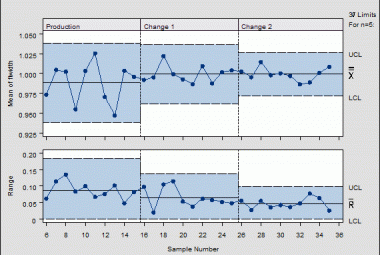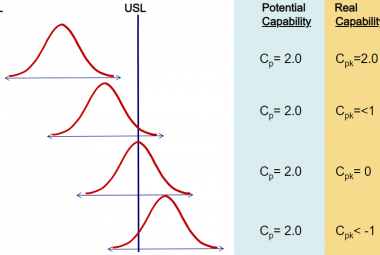The Gate of Purpose is positioned at the entrance of the Fortress of Change and includes multiple functions. Firstly, the gate has towers which makes it possible for the people in the gate to look at the horizon. The Fortress’s management can thereby create an image of the nearby future and create a plan on how to anticipate on that image. Deploying the company policy to all departmentsis what is known in the Lean philosophy as Hoshin Kanri. Secondly, the people at the gate determine who enters and leaves the fortress, a HR function. HR is also responsible for the development of the people in the fortress, to optimizing the People Value Stream, so everyone can contribute to the company objectives. Optimizing the People Value Stream is the second Lean principle used at the Gate of Purpose.
HOSHIN KANRI
The Principle of Hoshin Kanri (Policy Deployment) describes the alignment of all goals and performance indicators in accordance to the company goals. Every performance indicator should be directly related to the organization-wide indicators. Webers (2010) describes Hoshin Kanri at strategic-, tactical- and operational level as shown in the figure below.

At STRATEGIC LEVEL the organization needs to determine its mission. The mission describes what the organization is hoping to achieve, for instance: making sure every family in the world can have its own Product X. The mission is followed by the vision, which describes the future state of the organization, necessary to complete the mission, for example: the cheapest manufacturer of Product X. Communicating the vision of the organization, and agreeing on the company vision, is the first step in structured improvement. The vision cascades down to a strategy and describes how the organization is planning to reach the desired state of the vision. An example of a strategy is “having a continuous focus on cost reduction projects”. To manage the progress of the strategy, goals are defined of which “a yearly cost reduction of 5%” is an example. These goals in turn need to be translated to department specific Performance Indicators. The performance indicators measure whether or not the goals are met and therefore measure the progress of organizational change towards the company vision.
In practice, the strategic part of Hoshin Kanri can best be shared on paper (Floyd, 2010). This so called strategic intention should include the following five elements, roughly conform Weber’s break down: a description of the strategy to share how the organization is going to improve (1), the future state or vision of the company (2), the current state of the organization to show the improvement potential (3), the performance indicators which are used to measure progress of improvement (4) and performance targets to encourage improvements (5).
At TACTICAL LEVEL performance indicators are cascaded down to Control Indicators. Every department or workstation should have their own cascaded form of performance indicators. An indicator that is manageable and amendable for that department or workstation. The performance indicator ‘production costs’ can for instance be cascaded into ‘costs of defect product’ in a production environment or ‘cost of average machine downtime’ for a technical support group.
Traditionally control indicators contain three categories: Quality (1), Delivery (2) and Reliability (3) (Ballé & Ballé, 2005). A method to visualize these indicators and discuss them daily is by putting them on a departments Communication Cell.
The third level is OPERATIONAL LEVEL, where control indicators cascade down to Behavioral Indicators. The underlying theory is that operator performance is the direct result of his or her behavior. Traditionally, quality checks at the end of the process are in place to check for abnormal output. A better way of measuring a process is to check the behavior employees show while doing their task, in other words: to check on their standard work. This can be done using Kamishibai (mini-audits). Focusing on process-behavior instead of the quality check on output fits one of the 14 Lean principles of Toyota: being process oriented, not result oriented (Liker, 2004). Next to checking for deviations from standard way of working, kamishibai can be used to check behavior around 6S, Safety and team efforts in Kaizen. To be able to perform this way of measuring performance, it is important for Standard Operating procedures to describe not only what to do at a certain task, but also how to do it.
A second method to measure behavior is to regularly hand out surveys throughout the plant. By having employees rank statements such as “I know how to implement a Kaizen”, “my manager encourages me to implement kaizen” and “the organization values my ideas for improvement”, one can get an image about people’s perception on Management Behavior.
Apart from defining performance indicators and their alignment, management is also responsible for the growth of people in the organization to be able to contribute to the company goals. Human Resources’ most important function is therefore to maximize the PEOPLE VALUE STREAM (Liker & Hoseus, 2009).
To conclude, the gate of purpose represents some management functions as well as HR functions. The most important task for management is Hoshin Kanri: to develop a company vision and to translate it into measureable behavioral indicators. By implementing Hoshin Kanri, all improvement activities in the organization will directly contribute to the organizational goals and therefore to its mission. Aligning all Indicators results in measuring more significant results compared to a situation where each department has its own performance indicators, which can lead to departments individually striving for different indicators, leveling out each other’s results at organizational level.
This is article 2 in the series ‘The Fortress of Change‘
Continue to:
The Postoffice - Managing Communication
REFERENCES:
Ballé, F., Ballé, M.,2005, De Goudmijn – een Roman over Lean Transformatie, Driebergen (NL): Lean Management Instituut.
Floyd, R.C., 2010, Liquid Lean: Developing Lean Culture in the Process Industries, Productivity Press
Liker, J., 2004, The Toyota Way, 14 management principles from the world greatest manufacturer New York: Mc-Graw Hill (summary)
Liker, J., Hoseus, M., Toyota Culture, The Heart and Soul of the Toyota Way, New York: McGraw-Hill.
Webers, N.C.W., 2010, Performance Behaviour – De Lean Methode voor het Continue Verbeteren van Prestatiegedrag, Den Haag (NL): Sdu uitgevers












